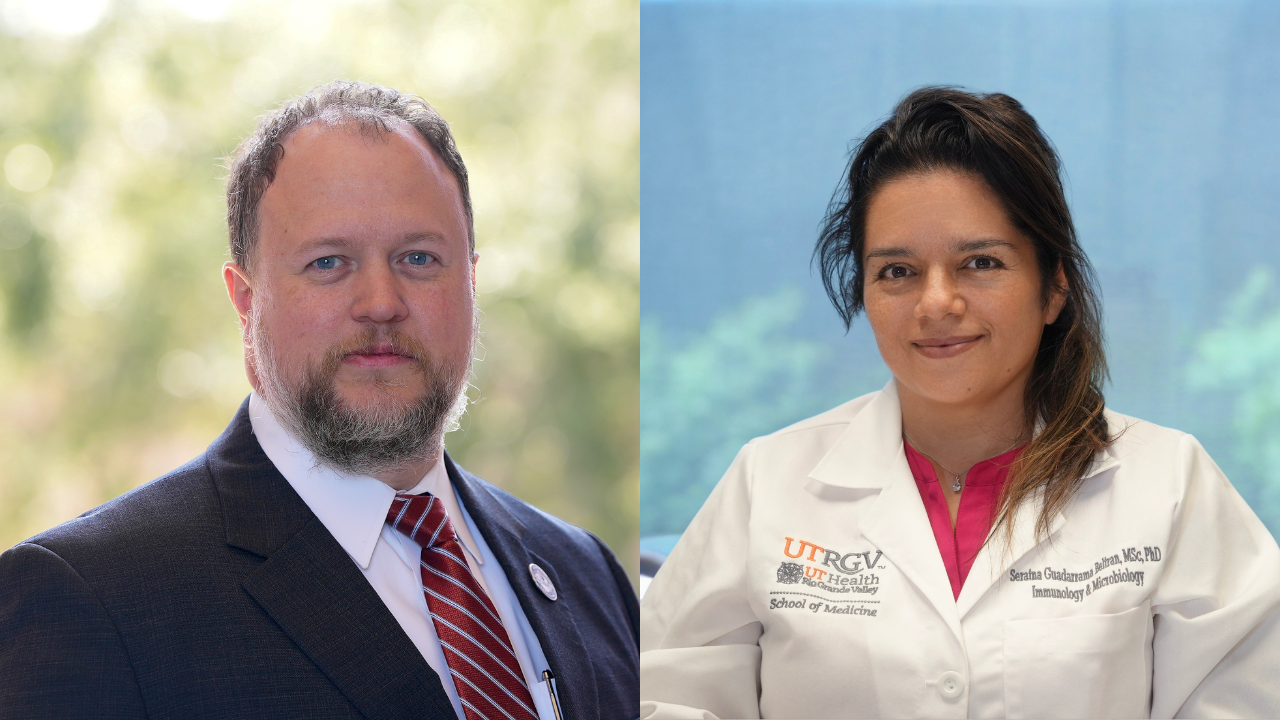NASA Solar System Ambassador Online Discussion Series
Space Microbiology | Dr. Thomas B. Spencer and Dr. Seratna Guadarrama Beltran

Written by María González
Photography by Jesús Alférez
RIO GRANDE VALLEY, TEXAS – NASA Solar System Ambassador and UTRGV Associate Vice President for Research Operations, Dr. Thomas B. Spencer, recently conducted an online discussion with Dr. Seratna Guadarrama Beltran, an expert in space microbiology at The University of Texas Rio Grande Valley (UTRGV). The conversation Dr. Guadarrama Beltran’s groundbreaking research, its impact on space exploration, and opportunities for students to grow their careers in space sciences.
Spencer opened the interview by introducing Guadarrama Beltran and highlighting the significance of her work, stating, “She is going to be talking about some of her amazing work and how it affects space sciences, and even better, how it can grow the careers of some students.”
Guadarrama Beltran began by outlining her primary area of expertise: “My area of expertise is found within the field of space microbiology, and my primary research is focused on how bacterial pathogens respond to environmental stressors, including altered gravity or spaceflight conditions.” She has worked extensively with bacteria and human cells under microgravity and other stressors.
Guadarrama Beltran shared key examples of her research, including her involvement with NASA’s Space Shuttle Transportation System (STS-95), where she studied how spaceflight affected human lymphoblastoid cells. “One of the major highlights in my career was assisting in assembling the experimental payload that flew in STS-95,” she said, adding that this mission also carried astronaut and senator John Glenn. “He was one of the first astronauts in the space program, and later, as a senior, he flew this mission because he was in such good physical condition.”
She also discussed her research on “Pseudomonas aeruginosa, an opportunistic bacterium, to understand how it responded to simulated microgravity conditions.” Her work revealed how the virulence, or the bacterium’s ability to infect a host, changed in space conditions. “We found several things in that study, and that project was also funded by NASA,” she noted. Another significant project involved “investigating the effect of low oxygen conditions on the virulence of Salmonella enterica serovar Typhimurium,” funded by Science Foundation Ireland.
“Virulence increased under these stressful conditions, which showed us how important it is to study these effects for future space missions,” she explained. She also noted that microbes’ resilience in space is a growing area of concern for NASA: “Microbes are resilient and can weaponize themselves in space, increasing their virulence.”
Turning to her current work, Guadarrama Beltran mentioned a recent award: “Not too long ago, our research group, which is composed of medical students, received an award for their oral presentation at the UTRGV College of Science Annual Research Conference.” Their research examines the interaction between oral microbiota and environmental stressors, which has important implications for astronaut health. “We’re studying how these interactions may play a role in neural degeneration and how environmental stressors could be managed to minimize this degeneration,” she added.
When asked about how her work impacts the broader field of space exploration, Guadarrama Beltran emphasized the importance of understanding microbes in space: “It’s crucial for NASA to ensure that we sterilize spacecraft and probes to minimize contamination, but it’s also important to understand that microbes are tough—there’s no such thing as 100% clean,” she explained. “We know from the Apollo missions that some microbes even survived on the moon. This shows just how resilient microbes are and why it’s essential to study them.”
Spencer praised her work, noting, “As we go back to space, understanding how microbes work is crucial, and your research is vital to future space exploration.”
Guadarrama Beltran also shared her personal journey, tracing her inspiration back to her childhood in Mexico. At a young age, she wrote to renowned scientist Dr. Carl Sagan, asking how she could pursue a career in the space sciences. “To my surprise, I got a response from him,” she said, explaining how Sagan’s encouragement led her to study microbiology and space biology. “He told me that I should go into microbiology or biochemistry to be prepared at a fundamental level in case we do find life beyond Earth—and if not, I’d still have marketable skills.”
Her passion for inspiring the next generation is evident in her work with students at UTRGV: “One of the main reasons I came back to Texas after working abroad was to make a difference in the communities here, especially for young minds from minority backgrounds,” she said. “I want to show them that a career in space sciences is not beyond their reach, and that they can explore their curiosity and make their mark in the world.”
Guadarrama Beltran is also working on developing future collaborations: “We’re in a very fortunate position, with SpaceX just around the corner. I’m working on a partnership with SpaceX to further connect our students with space science opportunities.”
Spencer concluded the interview by commending her commitment: “Be brave. You reached out to Dr. Sagan, and now you’re inspiring the next generation. Students, reach out, ask questions, and find your champion.”
Stay tuned for the full video of the online discussion, coming soon.
For more information on NASA’s Solar System Ambassador program, visit NASA’s website.
ABOUT UTRGV
The University of Texas Rio Grande Valley (UTRGV) was created by the Texas Legislature in 2013 as the first major public university of the 21st century in Texas. This transformative initiative provided the opportunity to expand educational opportunities in the Rio Grande Valley, including a new School of Medicine, and made it possible for residents of the region to benefit from the Permanent University Fund – a public endowment contributing support to the University of Texas System and other institutions.
UTRGV has campuses and off-campus research and teaching sites throughout the Rio Grande Valley including in Boca Chica Beach, Brownsville (formerly The University of Texas at Brownsville campus), Edinburg (formerly The University of Texas-Pan American campus), Harlingen, McAllen, Port Isabel, Rio Grande City, and South Padre Island. UTRGV, a comprehensive academic institution, enrolled its first class in the fall of 2015, and the School of Medicine welcomed its first class in the summer of 2016.
MEDIA CONTACTS
Maria.Gonzalez6@utrgv.edu
Communications Manager, Research Communications | (956) 665-5852
Jesus.Alferez01@utrgv.edu
Communications Specialist, Research Communications | (956) 665-7908
